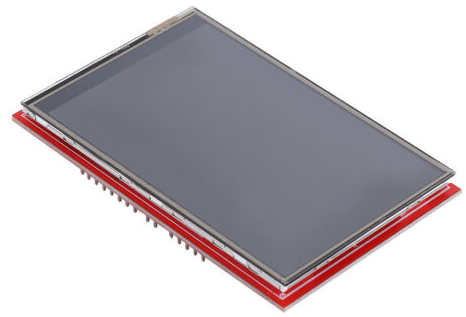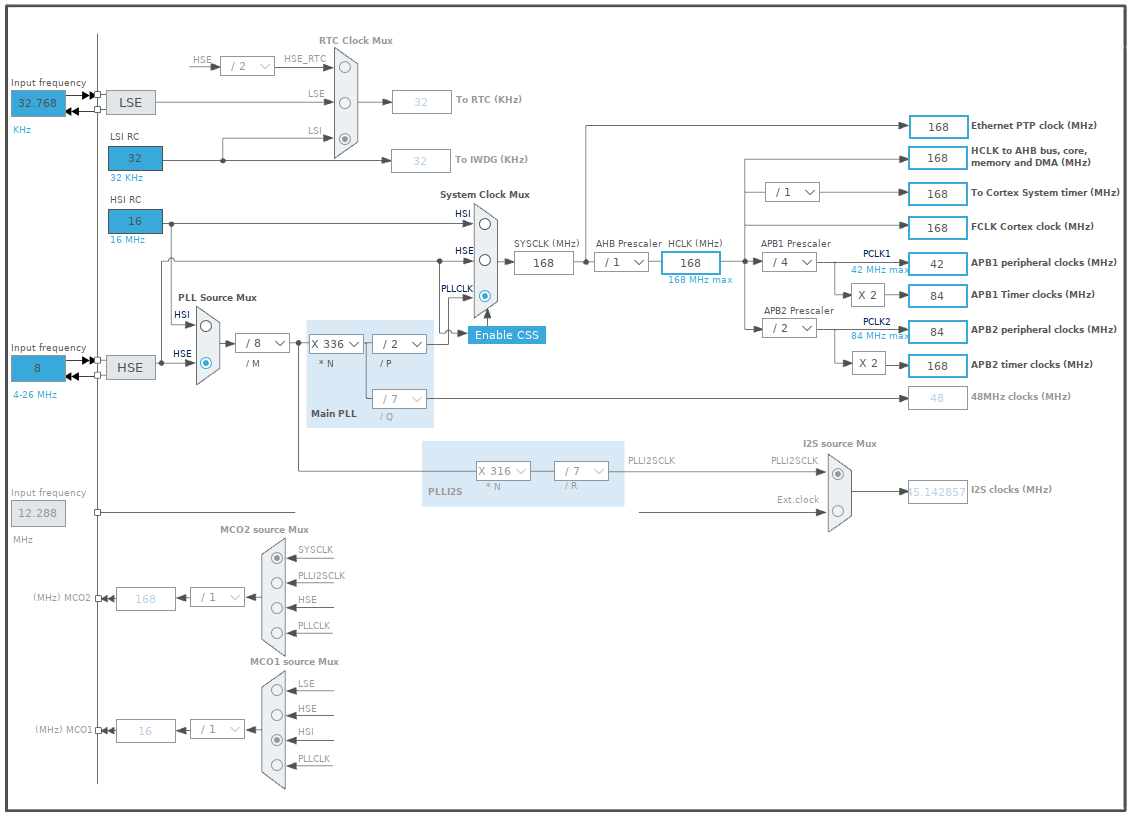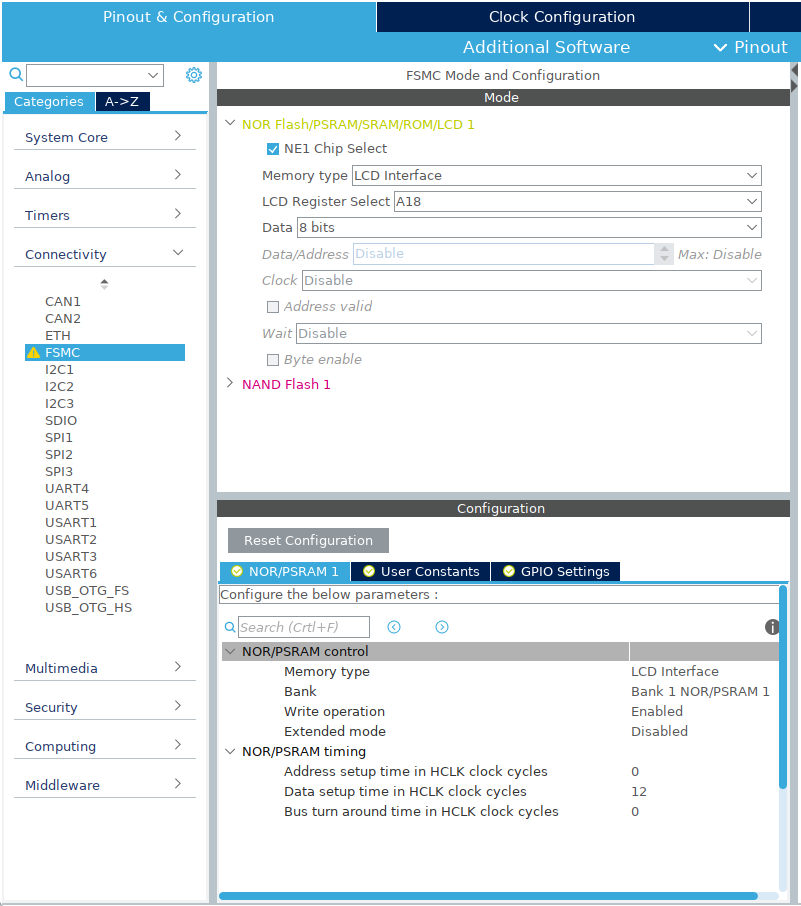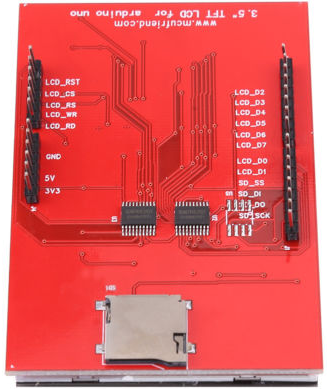3.5" inch TFT LCD Display Module 480X320 driven with FSMC.
TFT LCD Display Module 480X320 driven with FSMC
I have recently bought a 3.5" inch TFT LCD Touch Screen Display Module 480X320 with a www.mcufriend.com label on the back side. The display was equipped with an 8bit parallel interface. First I decided to test it with the UniGraphic library using the BUS_8 protocol. The display was very slow but improved when I switched to the PAR_8 protocol. Because I heard about the possibility to use a Flexible Static Memory Controller (FSMC), built into some STM MCU's, to drive LCD's (read/write to LCD's memory rather than to an external SRAM) I thought it would be a fun to try it out.

Below is the brief story of what I did:
- Created a project for my STM32F407VE board in the STM32CubeIDE
- Set the
Clock Configurationto match the one used by Mbed for the Seeed Arch Max board:
- Selected
FSMCin theConnectivitycategory and configured it as below:
- Let the
STM32CubeIDEgenerate the code (files). - Created a new program for the Seeed Arch Max target in the Mbed Online Compiler by selecting a
mbed os blinkytemplate. - Replaced the
main.cppwith themain.ccontent of theSTM32CubeIDEproject. Copy & Pastedthe other files with codes from theSTM32CubeIDEproject to the online compiler project.- Renamed and modified:
"stm32f4xx_it.h" to "stm32f4xx_it_msp.h"
"stm32f4xx_it.c" to "stm32f4xx_it_msp.c" - Added the UniGraphic library to the online compiler project.
- Extended the
UniGraphiclibrary with aFSMC_8protocol and replaced theTFT::set_orientation(int orient)function with the one used bymcufriendfor arduino. - Modified the
main.cppas needed.
 |  |
Wiring
| STM32F407VE | TFT LCD module |
|---|---|
| +3.3V | 3V3 |
| GND | GND |
| PB_12 | LCD_RST |
| GND | LCD_CS |
| PD_13 (RS) | LCD_RS |
| PD_5 (WR) | LCD_WR |
| PD_4 (RD) | LCD_RD |
| PD_14 (DB00) | LCD_D0 |
| PD_15 (DB01) | LCD_D1 |
| PD_0 (DB02) | LCD_D2 |
| PD_1 (DB03) | LCD_D3 |
| PE_7 (DB04) | LCD_D4 |
| PE_8 (DB05) | LCD_D5 |
| PE_9 (DB06) | LCD_D6 |
| PE_10 (DB07) | LCD_D7 |
Results
| Execution times | ||
|---|---|---|
| Used protocol | BUS_8 | FSMC_8 |
| Operation \ Time | ms | ms |
| Clear | 2283.980 | 38.454 |
| Plot | 192.066 | 11.365 |
| 8bit BMP | 63.805 | 41.338 |
| Large Font | 163.872 | 7.895 |
| Sparce pixels | 2072.265/1458.051 | 74.107/52.168 |
| 16bit BMP | 2288.589 | 59.904 |
UniGraphic/Graphics/TextDisplay.h
- Committer:
- hudakz
- Date:
- 2020-09-25
- Revision:
- 1:47c996032a9e
- Parent:
- 0:fa952828e34c
File content as of revision 1:47c996032a9e:
/* mbed TextDisplay Library Base Class
* Copyright (c) 2007-2009 sford
* Released under the MIT License: http://mbed.org/license/mit
*
* A common base class for Text displays
* To port a new display, derive from this class and implement
* the constructor (setup the display), character (put a character
* at a location), rows and columns (number of rows/cols) functions.
* Everything else (locate, printf, putc, cls) will come for free
*
* The model is the display will wrap at the right and bottom, so you can
* keep writing and will always get valid characters. The location is
* maintained internally to the class to make this easy
*/
#ifndef MBED_TEXTDISPLAY_H
#define MBED_TEXTDISPLAY_H
#include "mbed.h"
#include "Stream.h"
/** A common base class for Text displays
*/
class TextDisplay : public Stream {
public:
// functions needing implementation in derived implementation class
// ----------------------------------------------------------------
/** Create a TextDisplay interface
* @param name The name used in the path to access the strean through the filesystem
*/
TextDisplay(const char *name = NULL);
/** output a character at the given position
*
* @param column column where charater must be written
* @param row where character must be written
* @param c the character to be written to the TextDisplay
* @note this method may be overridden in a derived class.
*/
virtual void character(int column, int row, int c) = 0;
/** return number of rows on TextDisplay
* @result number of rows
* @note this method must be supported in the derived class.
*/
virtual int rows() = 0;
/** return number of columns on TextDisplay
* @result number of columns
* @note this method must be supported in the derived class.
*/
virtual int columns() = 0;
// functions that come for free, but can be overwritten
// ----------------------------------------------------
/** redirect output from a stream (stoud, sterr) to display
* @param stream stream that shall be redirected to the TextDisplay
* @note this method may be overridden in a derived class.
* @returns true if the claim succeeded.
*/
virtual bool claim (FILE *stream);
/** clear the entire screen
* @note this method may be overridden in a derived class.
*/
virtual void cls();
/** locate the cursor at a character position.
* Based on the currently active font, locate the cursor on screen.
* @note this method may be overridden in a derived class.
* @param column is the horizontal offset from the left side.
* @param row is the vertical offset from the top.
*/
virtual void locate(int column, int row);
/** set the foreground color
* @note this method may be overridden in a derived class.
* @param color is color to use for foreground drawing.
*/
virtual void foreground(uint16_t colour);
/** set the background color
* @note this method may be overridden in a derived class.
* @param color is color to use for background drawing.
*/
virtual void background(uint16_t colour);
// putc (from Stream)
// printf (from Stream)
protected:
virtual int _putc(int value);
virtual int _getc();
// character location
int _column;
int _row;
// colours
volatile uint16_t _foreground;
volatile uint16_t _background;
char *_path;
};
#endif